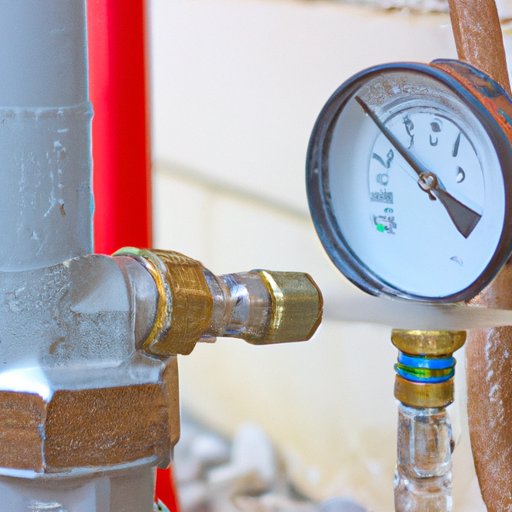
I. Introduction
Dealing with low or high water pressure in your house can be a frustrating experience. Low water pressure can make showers and laundry feel like a chore, while high water pressure can lead to damage to your appliances and plumbing. In this article, we will guide you through the steps on how to adjust water pressure in your house and prevent future problems.
II. Step-By-Step Guide: How to Adjust Water Pressure in Your House
Before we dive into the steps involved in adjusting water pressure, let’s take a look at the tools and materials you’ll need:
- Pressure gauge
- Adjusting tool (depends on your plumbing system)
- Teflon tape
- Bucket
Before you begin, make sure to turn off the main water supply to your house and drain all the water from your pipes by turning on all faucets and plumbing fixtures.
Once you have these tools and materials, you can proceed with the following steps:
- Locate your pressure regulator valve. This valve typically looks like a bell-shaped object located near your main water supply.
- Connect the pressure gauge to an outdoor spigot or a faucet close to your pressure regulator valve. Open the faucet or spigot and read the pressure gauge. If the pressure is below 40 psi or above 85 psi, you need to adjust it.
- Using the adjusting tool that corresponds to your plumbing system, turn the screw on the regulator valve clockwise to increase pressure and counterclockwise to decrease pressure.
- Check the pressure again with your gauge and continue adjusting until it reaches the desired pressure.
- Once you have adjusted the pressure, turn off the faucet or spigot and turn on the main water supply. Check all your plumbing fixtures for proper pressure.
- If you notice any problems, check for leaks and air in the pipes. Adjustments may need to be made until everything is working properly.
III. DIY Plumbing: Lowering or Raising Your Home’s Water Pressure
Depending on the type of plumbing system you have, there are different methods for lowering or raising the water pressure in your house.
Private Well
If you have a private well, low water pressure can be caused by a number of factors, such as a damaged pump or clogged well screen. To fix this, you need to diagnose the problem and repair or replace the necessary parts. Raising the water pressure in a private well system can be done by adjusting the pump setting or installing a booster pump.
Municipal Water Supply
If you are connected to a municipal water supply, the water pressure can be adjusted by locating the pressure regulator valve and following the steps outlined in the previous section.
Alternative Methods
If you are unable to adjust your water pressure by adjusting the regulator valve or installing a booster pump, there are alternative methods you can try. For example, installing a water pressure tank can help to regulate the pressure in your plumbing system.
IV. Troubleshooting Water Pressure Problems and Adjusting Them Accordingly
Low or high water pressure can be caused by a number of factors. Here are some common reasons for water pressure problems and how to adjust them:
Low Water Pressure
- Clogged aerator: Clean or replace the aerator in your faucet
- Pressure regulator failure: Replace the regulator valve
- Leak in the plumbing system: Hire a plumber to find and repair the leak
High Water Pressure
- Pressure regulator failure: Replace the regulator valve
- Partially closed valve: Open all the valves in your plumbing system
- Thermal expansion: Install a thermal expansion tank
V. The Importance of Proper Water Pressure and How to Adjust It
Proper water pressure is important for the lifespan of your household appliances and plumbing. Low water pressure can cause appliances to work inefficiently and take longer to complete tasks. High water pressure, on the other hand, can damage appliances and cause pipes to burst.
By adjusting your water pressure to the optimal level, you can save money on your water bill and prevent future problems with your plumbing system.
VI. Common Causes of Low or High Water Pressure in Your Home and How to Adjust Them
Here’s a summary of the common causes of high and low water pressure:
Low Water Pressure Causes
- Leak in the plumbing system
- Clogged aerator
- Pressure regulator failure
- Corroded pipes
High Water Pressure Causes
- Partially closed valve
- Pressure regulator failure
- Thermal expansion
- City pressure too high
To adjust these common causes of low or high water pressure, follow the steps outlined in the previous sections or seek the advice of a professional plumber.
VII. Conclusion
Adjusting water pressure in your house is an important step in maintaining the health of your plumbing system and household appliances. By following the step-by-step guide outlined in this article, you can adjust your water pressure to the optimal level and prevent future problems. Remember to always take safety precautions and seek professional advice when necessary.




